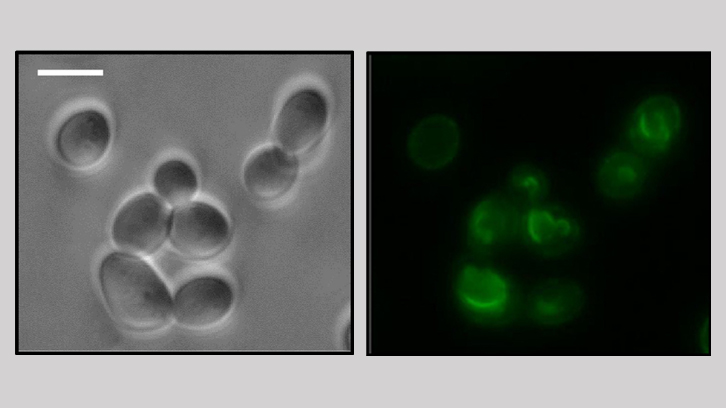Discovery of a predictive sequence for multifunctional proteins in yeast

The Yeast Molecular Biology laboratory at UAB has discovered during their research several proteins that are likely to be multifunctional, namely Hal3 and Vhs3, which regulate a protein phosphatase and may also form a key enzyme for the synthesis of coenzyme CoA. They have recently demonstrated that a short sequence of these proteins can act as a predictor of their multifunctionality.
The classic notion that in cells one protein corresponds to one function was drastically altered about 40 years ago when evidence was found that certain proteins could fulfill completely different functions in the same cell. These types of proteins were called “multifunctional” (or “moonlighting” proteins). The Yeast Molecular Biology laboratory at UAB discovered a notable case a few years ago: the Hal3 and Vhs3 proteins. Hal3, and later Vhs3, were identified as negative regulators of a protein phosphatase, Ppz1 (discovered in our own laboratory). This phosphatase has a crucial role in the maintenance of sodium and potassium cation fluxes and has been identified as a virulence determinant in some fungal pathogens. But surprisingly, while Ppz1 is a phosphatase found exclusively in yeast and fungi, it was possible to identify proteins with high similarity to the Hal3 or Vhs3 core region in any organism, from humans to bacteria.
A key piece of this puzzle emerged when it was discovered that the Hal3-related protein in the plant Arabidopsis thaliana (AtHal3) was a key enzyme, called PPCDC, of the coenzyme A (CoA) synthesis pathway, and that it functioned as a homotrimer. CoA is a very important coenzyme in many highly conserved metabolic pathways, such as fat breakdown. Starting from this base, our group discovered that in the yeast Saccharomyces cerevisiae both Hal3 and Vhs3 interact with another similar protein (Cab3) to form a PPCDC made of 3 different components, where Hal3 (or Vhs3) formed a functional catalytic center upon interaction with Cab3. Therefore, in this yeast, both Hal3 and Vhs3 fulfilled the requirements to be considered multifunctional proteins, while Cab3, which was not acting as a regulator of Ppz1, did not. This scenario was considered, at that time, generalizable to any yeast.
However, more recent investigations on the pathogenic yeast Candida albicans revealed that, in this case, the protein with multifunctional capacity (regulation of Ppz1 and participation in the formation of an active PPCDC) was Cab3 (CaCab3) and not Hal3 (CaHal3). This anomaly remained unexplained until this year, when our group demonstrated that a short sequence at the amino terminus of Hal3 is key to fulfilling its role as a regulator of the phosphatase (without participating in CoA biosynthesis). This sequence was present in CaCab3, but not in the CaHal3 protein. Deletion of this sequence rendered CaCab3 useless as a regulator of Ppz1. Therefore, the presence of this sequence could be used as a predictor of Cab3 or Hal3 moonlighting ability. An analysis of the sequences present in fungi suggests that the case of C. albicans would not be unique but could extend to a group of evolutionarily related fungal organisms.
Department of Biochemistry and Molecular Biology, Institut de Biotecnologia i Biomedicina, Universitat Autònoma de Barcelona.
References
Casamayor A, Ariño J. Fungal Hal3 (and Its Close Relative Cab3) as Moonlighting Proteins. J Fungi (Basel). 2022 Oct 11;8(10):1066. doi: 10.3390/jof8101066. PMID: 36294631; PMCID: PMC9604783.
Santolaria C, Velázquez D, Albacar M, Casamayor A, Ariño J. Functional mapping of the N-terminal region of the yeast moonlighting protein Sis2/Hal3 reveals crucial residues for Ppz1 regulation. FEBS J. 2022 Dec;289(23):7500-7518. doi: 10.1111/febs.16572. Epub 2022 Jul 18. PMID: 35811492.


